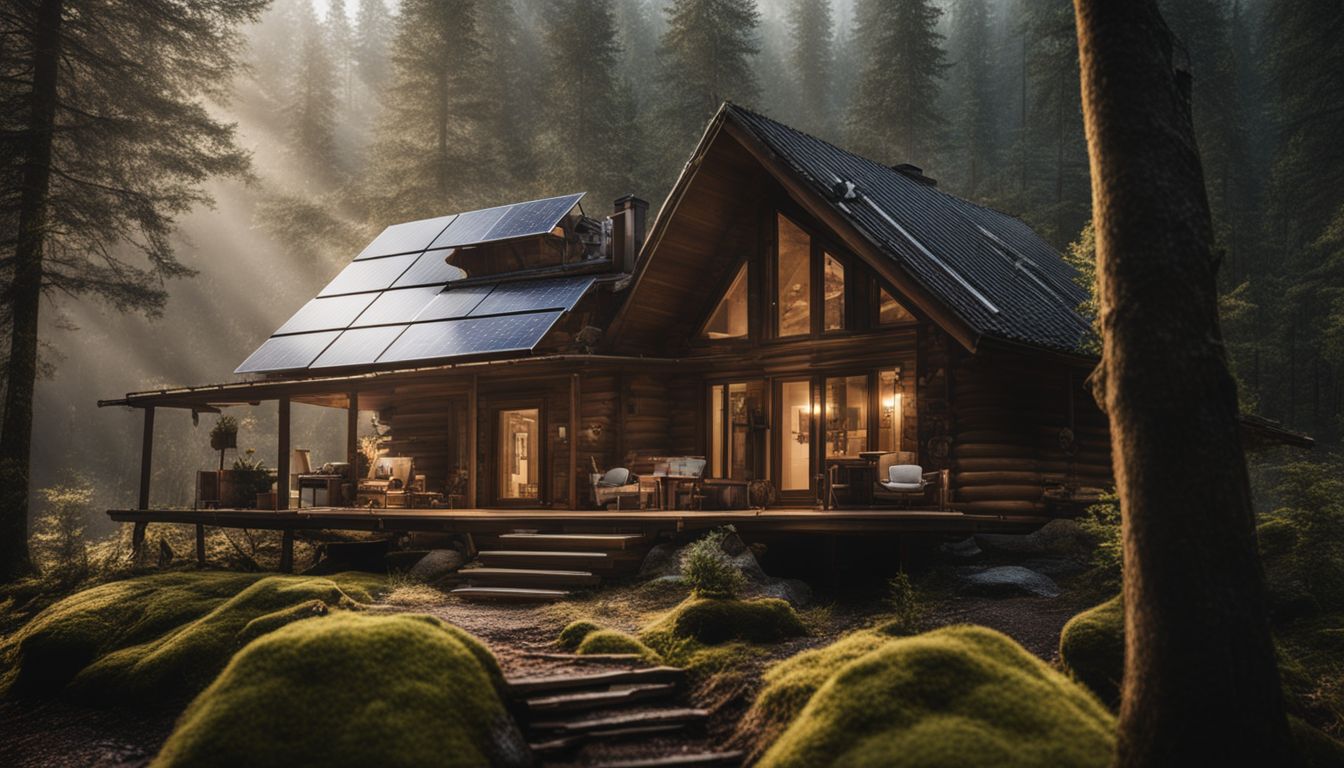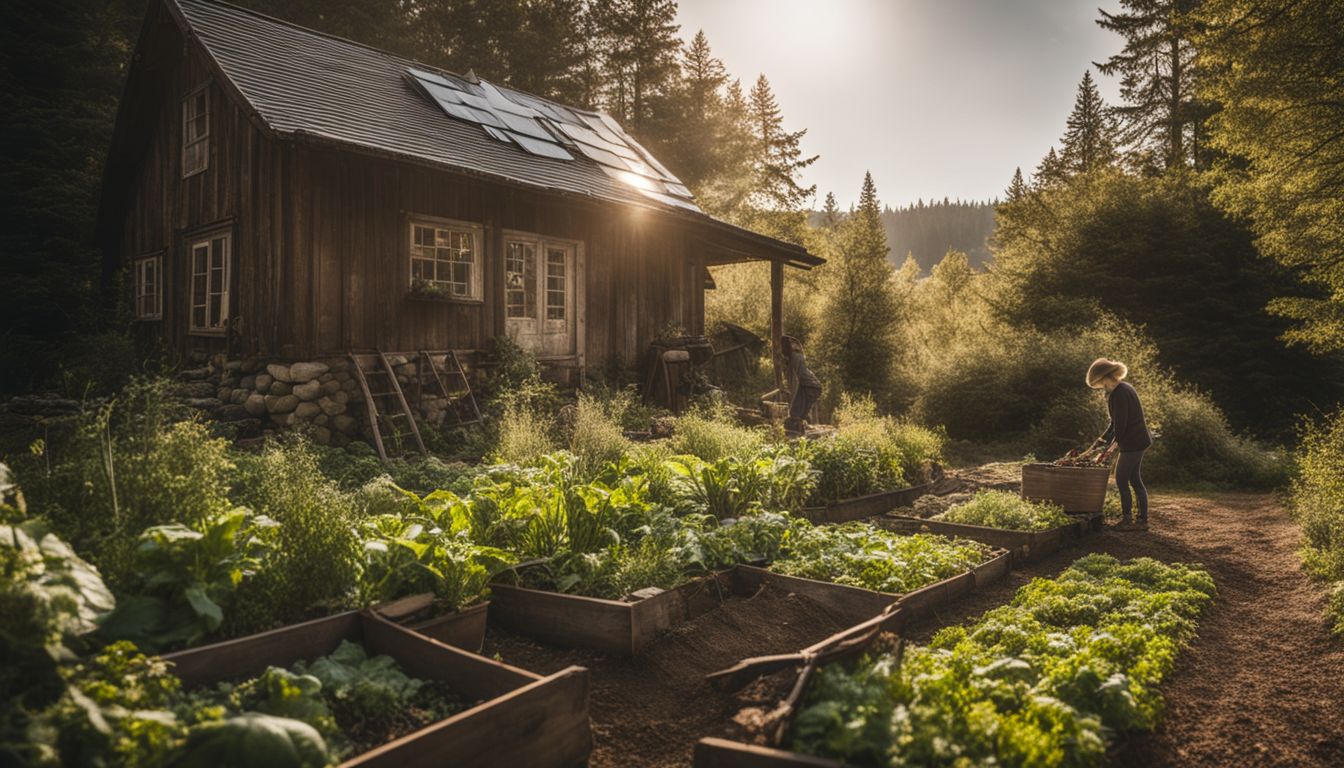
By: Alternative Habitat Blueprint
How to Live Off the Grid: The Ultimate Guide to Going Off-Grid with No Money
Many people dream of escaping the hustle and bustle. In 2023, more are choosing to live off the grid than ever before. This guide shows how to achieve that with no money, focusing on sustainable living and self-sufficiency.
Read on for a life-changing journey.
Key Takeaways
- Off – grid living means making your own power, growing food, and handling waste water by yourself. You need solar panels for electricity and at least 1000 sqm of land.
- To live off the grid, find land with sunlight and a good growing season. Use solar power for electricity and drill a well for water. Grow your own food using sustainable farming methods like permaculture.
- Living off the grid requires skills in reducing electricity use, saving money creatively, growing and preserving food. Learn about different types of solar panels and how to store energy.
- Off-grid communities offer support by sharing resources and knowledge on self-sufficiency in energy, water, and food production. They help people feel less isolated while living this lifestyle.
Understanding Off-Grid Living

Living off the grid means being self-sufficient and independent from traditional utilities like electricity and water. It offers freedom from the constraints of modern living, although it requires careful planning and resourcefulness.
Definition and Meaning
Off-grid living means you make your own power, grow food, and manage waste water on your own. You don’t rely on the normal society for these basic needs. This way of life needs a lot of planning, work, and money at the start.
Solar panels are very important for making electricity in off-grid homes.
People often need at least 1000 square meters of land to live off-grid properly. This lifestyle can be lonely sometimes. However, there are places where people who like this kind of life can meet and live together.
Pros and Cons
Exploring the benefits and challenges of off-grid living reveals a path towards autonomy, yet demands careful consideration. The table below outlines key aspects:
| Pros | Cons |
|---|---|
| Self-sufficiency increases | Initial costs are high |
| Environmentally friendly | Can feel isolating |
| Access to sustainable technologies | Requires significant time and energy |
| Freedom from utility bills | Reliance on weather for energy |
| Community living spaces available | Upfront investment in land and housing |
| Passive heating and cooling techniques | Maintenance of systems is ongoing |
As someone who has navigated the transition to off-grid living, I’ve experienced firsthand the peace that comes with autonomy. The journey involved learning to grow food and embracing solar power, tasks both rewarding and complex. I found community living spaces invaluable for connecting with like-minded individuals, mitigating feelings of isolation. This lifestyle aligns closely with the values of alternative house design enthusiasts, offering a blend of innovation and sustainability. While the upfront investment in solar panels and water systems may seem daunting, the long-term benefits—like freedom from utility bills and a reduced environmental footprint—make it worthwhile. Through careful planning and commitment, off-grid living proves both feasible and fulfilling.
Steps to Living Off the Grid

Step 1: Find suitable land for building or buying an off-grid home.
Step 2: Establish a reliable water source for your off-grid lifestyle.
Step 3: Develop and maintain a sustainable food supply to support your off-grid living.
Locating Suitable Land
Finding the right piece of land is key for living off-grid. You need at least 1000 sqm to build your home, grow food, and catch rainwater. Look for places with lots of sunlight and a growing season that lasts six months or more.
This way, you can use solar power systems effectively and have enough time to grow your own food.
I once searched for land that met these conditions. It wasn’t easy, but I found a great spot with the perfect climate. The area gets plenty of sun year-round, making it ideal for my solar panels and garden.
Next up is figuring out how to build or buy an off-grid home on this promising parcel of earth.
Building or Buying an Off-Grid Home
When it comes to building or choosing an off-grid home, timing and construction method are crucial. Solar power is a key part of off-grid living, so reliable solar systems with various types of solar panels are essential.
Also, an off-grid home relies on a natural water source like a well. Waste disposal can be managed through traditional septic systems or composting waste disposal systems.
Establishing a Water Source
When it comes to living off the grid, establishing a reliable water source is crucial. Off-grid water systems require careful planning and monitoring. Consideration for wells, spring water, and backup options in case of shortages or power outages should be prioritized.
An off-grid home requires a reliable water source, such as a well, for a cost-effective and low-maintenance solution. Ensure that your off-grid system includes provisions to manage waste disposal and efficient water management.
In this context, drilling a well along with setting up rainwater collection systems will provide sustainable and independent access to clean water. It’s also essential to consider backup plans for instances when the primary sources might face challenges due to climatic changes or other unforeseen circumstances.
Developing a Food Supply
After establishing a water source, the next crucial step in off-grid living is developing a sustainable food supply. Embracing this lifestyle means growing your own food to be self-reliant and reduce dependency on mainstream society.
Sustainable farming methods, such as permaculture and aquaponics, can help maximize yields with minimal resources by cultivating diverse crops and utilizing natural ecosystems for efficient use of space and resources.
Implementing strategies like rainwater harvesting, composting, and organic gardening techniques will ensure a continual supply of fresh produce without relying on external sources.
Setting Up Solar Power System
Setting up a solar power system for off-grid living requires careful planning and investment. The cost can range from $10k to over $75k, depending on location and energy needs. Understanding the three main types of solar panels – monocrystalline, polycrystalline, and thin film – is essential.
Additionally, battery storage options like flooded lead acid, AGM or lithium ion batteries are crucial for storing generated electricity. Other components include charge controllers, inverters, breakers, wiring and fuses…
Planning efficiently is key to building a sustainable off-grid solar power system that can provide reliable electricity.
Implementing Waste Disposal System
Implementing a waste disposal system in off-grid living involves options like composting toilets, traditional septic systems, or greywater treatment. Composting toilets are eco-friendly, turning human waste into fertilizer.
Meanwhile, traditional septic systems process waste underground using natural processes. Greywater treatment recycles water from sinks and showers for non-drinking purposes. Each method varies in cost, maintenance needs, and environmental impact – so choose wisely based on your resources and sustainability goals.
Off-grid living promotes sustainable practices such as responsible waste disposal methods that align with the environment and self-sufficiency values. Effective implementation of a suitable waste disposal system is crucial alongside other self-reliant practices like growing food and managing water sources to ensure a harmonious off-grid lifestyle.
Essential Skills for Off-Grid Living
4. Essential Skills for Off-Grid Living require learning how to grow and preserve food, reducing electricity usage, finding creative ways to save and earn money, and self-educating on off-grid living.
These skills enable sustainable living without relying heavily on external resources.
Growing and Preserving Food
Growing food is a cornerstone of off-grid living, promoting self-sufficiency and eco-friendly practices. Utilizing sustainable gardening techniques and drip irrigation systems allows for the cultivation of fresh produce in an off-grid setting.
Additionally, preserving food through methods such as canning, pickling, and drying ensures a constant supply of nourishment throughout different seasons. Embracing communal gardens fosters collaboration among off-grid community members, encouraging the sharing of resources for a robust and diverse food supply.
In the exciting realm of alternative house design lovers’ community, growing your own sustenance goes beyond just plant life; it’s about fostering a sustainable lifestyle that underpins the core principles of off-grid living with practical experiences at its heart.
Reducing Electricity Usage
To reduce electricity usage in off-grid living, consider using LED lights which consume less power. Upgrading appliances to energy-efficient models and turning them off when not in use can significantly cut down on electricity consumption.
Additionally, employing smart power strips that automatically shut off electronics can help minimize standby power usage. Embracing these practices aligns with the goal of sustainable and cost-effective living.
By integrating solar panels and batteries into the home’s energy system, it becomes possible to generate and store renewable energy for later use. This approach reduces reliance on traditional grid electricity, contributing to a more self-sufficient lifestyle while also cutting costs associated with conventional power sources.
Creative Money Saving and Earning
Reducing electricity usage paves the way for creative money-saving and earning opportunities in off-grid living. Harness renewable energy sources such as solar or wind power to generate surplus electricity, which can be sold back to the grid for extra income.
Embrace a self-sufficient lifestyle by growing and preserving your own food, saving on grocery expenses while potentially selling excess produce through local markets or community-supported agriculture initiatives.
Maximize cost-efficiency with high-capacity power stations and portable solar generators that provide reliable power without relying on the centralized grid systems. Utilize drip irrigation methods for efficient water usage in gardening, reducing utility costs.
Additionally, consider passive solar design elements when building or buying an off-grid home to minimize heating and cooling expenses. Engaging in these practices not only fosters financial independence but also contributes positively to sustainable off-grid living.
Entities from Concepts: renewable energy sources – hyponyms: photovoltaic panels
Self-Education on Off-Grid Living
Transitioning from creative money-saving and earning to self-education on off-grid living is essential for those venturing into alternative house design. It’s crucial to understand practical skills like growing and preserving food, reducing electricity usage, and finding ways to earn money independently.
Understanding the complexities of solar power systems, water management, waste disposal methods, along with legal considerations will underpin successful off-grid living. Exploring entities like ‘solar energy,’ ‘waste disposal system,’ and ‘water supply’ can provide a tailored approach towards mastering the ever-evolving realm of off-grid living.
Integrating first-hand experiences in cultivating food or managing alternative power sources can unlock the secrets necessary for thriving in an off-the-grid lifestyle.
Off-Grid Living Communities and Resources
Off-grid living communities offer support and shared knowledge, promoting a sustainable lifestyle. These communal setups often emphasize self-sufficiency in energy, water, and food production.
Tiny home cooperatives and intentional communities are popular choices for like-minded individuals to live in close proximity, sharing resources and skills. Many off-grid living resources provide guidance on legal considerations, land access, sustainable building options, and creating a thriving community.
Sustainable technologies like solar power systems can be explored through workshops or online forums within these communities.
Next heading: 6. Conclusion.
Conclusion
Living off the grid is an achievable and sustainable lifestyle choice. It requires careful planning, essential skills, and a shift in mindset towards self-sufficiency. Locating suitable land, building or purchasing an off-grid home, establishing water sources, developing food supplies, setting up solar power systems, implementing waste disposal methods are crucial steps for success.
Additionally, understanding essential skills for off-grid living and utilizing available resources such as communities is vital for those embarking on this path to live harmoniously with nature and lead a self-reliant life.